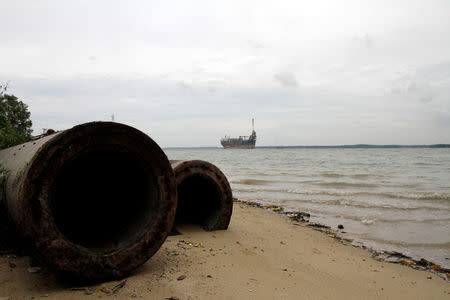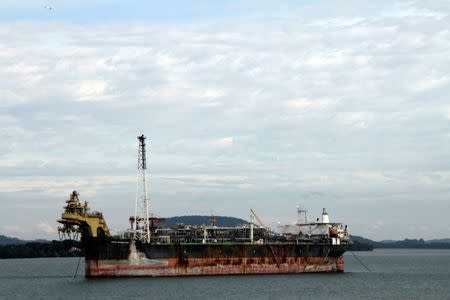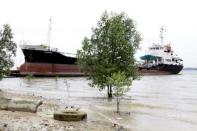Oil bet gone wrong: rusting tankers and rigs clog up Asian waters
By Henning Gloystein JOHOR, Malaysia (Reuters) - Some 15 km (9 miles) from the bustling port of Singapore,a rusting tanker as big as the world's largest aircraft carriers lies idle in a muddy estuary flanked by mangrove trees on the coast of southern Malaysia. The 340-metre (1,115 ft) "FPSO Opportunity", a hulking so-called Floating Production, Storage and Offloading (FPSO) vessel capable of drilling for oil in deep waters, is currently surplus to requirements along with scores of other rigs, tankers and support vessels in an era of cheap oil. The fleet of mothballed giant vessels anchored around Southeast Asian waters is the physical fallout of an oil downturn heading into its third year, and a stark reminder of how badly the industry miscalculated market conditions. "There was a misguided focus on scarcity in the supply side from the early 2000s," said David Fyfe, head of research at oil and commodity trading firm Gunvor. "As an industry, they were complacent. They thought because cost was high, prices will remain high ... (but) then there was the advent of shale. Since that period, there is a realization that there is no scarcity of oil." The shale revolution turned the United States into one of the world's biggest oil producers, at a time when exporters in the Middle East and Russia were also pumping out record volumes, causing oil prices to more than halve since mid-2014 to under $50 per barrel. The FPSO Opportunity, which has been laid up for over two years, was built in 1972 and operated by Chevron and Australia's Woodside Petroleum before being taken over by a Bermuda-registered FPSO Opportunity Inc in 2011. The newest owner could not be reached for comment. NEW LANDSCAPE The growing number of vessels anchored in the Johor river estuary is changing the landscape for the locals. "I've been coming here to fish every day for 10 years, and never have there been more ships parked," said an angler named Aiman, sitting on an unused pipeline lying on the beach. "It is quite intimidating to come here before dawn and to find, with the first rays of sun, another big ship has been parked here," he added, with his line dangling in the river. And it's not just Malaysia that has become the dumping ground for idled oil equipment. Across the Singapore Strait, in the bays of Indonesia's Batam island, over a hundred oil drilling and support vessels have been sitting idle for months, or even years. While laying up ships is legal and even provides profit to specialist mothballing companies, environmental groups say the growing number adds to the risk to flora and fauna. "The idling oil tankers risk polluting the marine environment, which a sizable population of the riverine fishermen rely on for their living," said Vincent Chow, chairman of the Malaysian Nature Society in Johor, citing the threat of dissolving paint and potential leakage of heavy metals and fuel into the sea. COST OF DOING NOTHING The armada of laid-up vessels shows how the shale boom caught the oil industry off guard and scuppered plans to drill for new fields. Energy consultancy Wood Mackenzie said global exploration spending halved in 2015, while BMI Research sees capital expenditure among oil producers suffering another sharp decline this year. Struggling drilling companies are paying to lay up rigs in the hope they will survive until demand picks up again. [nL3N1BU024] The cost depends on size and location, and whether they are in a so-called "hot lay-up", whereby equipment is kept operational so the vessel quickly returns to service, or "cold lay-up" whereby ships can be mothballed for years. Cold lay-up for a rig or large oil tanker costs $20,000 to $25,000 a month in Johor, said Balasubramanian Krishna, operations manager at Malaysian lay-up specialist Ocean Shipcare, while laying-up a small supply vessel costs $3,000 to $4,000 a month. Matti Bargfried, head of marketing at maritime software company CODie, said a lay-up time of several years could make re-commissioning lengthy and costly. "The main concern here is preservation against humidity, leakage of chemicals and condition of the hull," he said. This means that some of the idled vessels may have to be scrapped in yards in countries such as India or Bangladesh, although shippers say the current cost of the journey may be more than their scrap value. (Additional reporting by Emily Chow in KUALA LUMPUR, and Keith Wallis, Rania El Gamal and Mark Tay in SINGAPORE; Editing by Richard Pullin and Ed Davies)

 Yahoo News
Yahoo News 











